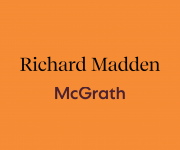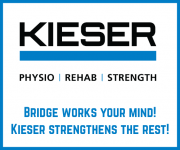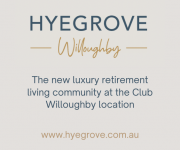Mark has plenty to say this month

The North Shore Bridge Club has had a relatively strong year, especially in comparison with other Australian and International bridge clubs. That is not to say that everything is perfect, or that there aren’t areas of concern, but overall, I am very happy with the state of our club.
I am going to talk through a few different areas to give you more insight.
Table Numbers
The point of a bridge club is for people to play bridge, so table numbers are a key measure of the health of the club. Our table numbers are strong with over 300 tables per week. It was a struggle to get people back to face-to-face bridge after the pandemic, but Mike has done an excellent job and we now have healthy numbers across both face-to-face venues and online. It is very important that we can offer both ways of playing bridge for our members, and I am also working as part of an ABF committee to look at how we can get both online and face-to-face bridge to work as effectively as possible together.
Membership Levels
When we go through the annual membership renewal process, we usually lose about a third of our members and they gradually pick up again throughout the year. This year we lost significantly less than normal, and our membership currently sits just above 1,700. The vast majority of our members are Sydney based, primarily in the North Shore and surrounding areas, but we have players from every state in the country and New Zealand and we welcome the contribution that they bring to the club.
Member Feedback
Our members are very engaged with the club and of course are the club.
For such a large club, with so many things going on, we get surprisingly little critical feedback. I don’t think this is in any way a bad thing, I believe it just means that you, as members, are happy and are focussing on your bridge as you should. When we raised the table fees in November Mike got about 10 emails from members. The vast majority were positive and thanking Mike for the work the club does.
Most of the feedback we do get is extremely positive, with people suggesting ways to improve things. I encourage everyone to continue to help us in this regard.
Diversity of Games
We try to offer a complete range of support for our members, from beginners’ lessons through to advanced lessons, from supervised play all the way through to our Thursday night competition, and our program of congress events throughout the year.
The one area I don’t think we have managed to address post-Covid, is to get a consistently strong face-toface session. I do get some stronger players asking about this, but unless we get enough of you who want to play at the same time there isn’t a lot we can do about it.
Evening bridge continues to prove difficult. This isn’t unique to us, evening bridge worldwide has been on the decline for a long time, well before Covid came along. While this is disappointing as it makes it harder for us to appeal to people who are still working, if there is no demand then there is little, we can do about it.
That aside, I believe our range of times and locations (online and face-to-face) provides great opportunities for our members to play a lot of bridge.
Staff
We are fortunate enough to have the size and the scale to be able to employ permanent staff to work for us.
We are even more fortunate that we have such good people in these roles.
Mike Prescott as the Club Manager is central to everything that we do. Running a bridge club is a difficult and highly specialised job. There are very few people with the right mix of skills and experience around and Mike is the standout best Club Manager in Australia. We are very lucky to have him.
Gary Barwick is our Online Bridge Manager. This is another highly specialised role requiring not just knowledge of bridge, but also deep understanding of technology. Gary is a huge asset to the club and provides advice and support for all of our members and online directors. Gary also has a lot of ideas, and this year has been looking at new and innovative ways to run online bridge events including the excellent Across the Ditch and Down Under vs Up Over events on RealBridge as well as pushing for more competitive games across all levels of play.
Sue Crompton manages East Lindfield for us. As well as directing, Sue handles a lot of the aspects of the venue that will not be obvious to most people. Sue also has a lot of great ideas and is an essential link for Mike and me, with everyone who plays at East Lindfield. Sue also has a great relationship with the team at East Lindfield Bowling Club.
Josh Ogle is a familiar and friendly face for those of you who play at The Willis. Josh does everything from making tea to dealing boards to moving furniture.
This year we have a new addition to the team with Fiona Lavery taking on the role of Teaching Coordinator. Fiona has only recently started but is already making a big difference with her ideas and her energy.
Two of our staff took a step back this year, after both had provided many years of great service to the club. Margaret Owen was our Membership Secretary but did an awful lot more than that for the club. Margaret has stepped down to focus on things at home and also to play more bridge. Similarly, Kay Moyes is also hoping to play more bridge having been the teaching co-ordinator to great effect for many years. We wish them both well and thank them for everything they have done for the club.
Volunteers
While it is great that we have staff, any club also needs a healthy attitude to helping out when needed and we are very lucky to have so many members who help out in any way they can. At our congresses we get some of the best home-baked goods you could ever want to taste, and volunteers help out in many other ways such as checking up on members or giving people a lift to bridge when they need it.
A special mention goes to Kevin Davies for the enormous amount of work that he does for the monthly Newsletter and to Leo Goorevich who manages our web site so well.
Directors
I have never directed a session of bridge. I imagine it requires a vast range of skills to be an effective director. You need to know the rules to one of the world’s most complex games for a start, you need to be able to work out movements, deal with late arrivals, manage a room full of people and keep smiling however difficult it all gets.
Directing online bridge removes some of the work required for face-to-face as RealBridge does a lot of this, however, it gets replaced with having to deal with technology problems which can often be very hard to diagnose.
We have some of the best directors going around. Allan Pike, Angie Boulton, Brian Soutter, David Hagley, Fiona Lavery, Jamie Thompson, Jenny Barnes, John Newman, Kim Neale, Malcolm Martin, Ronnie Ng, Sandra Da Silva and Sue Crompton are all first-rate directors. Ronnie Ng and Matthew McManus are also National Directors and run our congresses for us. Without these people there would no bridge games and I am very thankful for their efforts and skills.
Teaching
We have a wonderful teaching program that covers all levels of skill. Anita Curtis, Jessica Brake and Liz Wilkinson do a fantastic job of teaching beginners and improvers. Our teaching program is the envy of clubs across the world. Fiona Lavery, John Newman, and Ann Pettigrew round out the teaching team and many others help throughout the year with supervised sessions and support. Additionally, this year, Mike was able to get time from Andy Hung and Pete Hollands to run some online lessons for us which were extremely well attended and received.
The Committee
Our committee consists of Jane Russ (Vice President), Sharon Thompson (Secretary), Rod Owen (Treasurer), Carol McMurray, Ian MacLaren and Jake Andrew. We have had a busy year as a committee with many areas requiring attention. While everyone on the committee has done a lot for the club, I would like to make special mention of Sharon Thompson who has worked tirelessly across many areas to improve things for the club. Her energy and patience as well as her technical skills are wonderful to behold, and we are extremely fortunate to have her involved.
Jane and Carol are stepping down from the committee this year and I would like to thank them for everything they have done for us.
Sponsors
I would like to thank our sponsors who I am sure you are all familiar with. TBIB, Two Men and a Truck, Morgans, Falls Estate, Watermark Residences and Highgrove Willoughby. I believe that our sponsorship arrangements provide good value for us and for the sponsors and it is great to see that so many are multi-year relationships.
Providers
Kit Myers has again been our bookkeeper through his company Compukeep and continues to be a trusted partner for us. Christopher Coote was again our auditor and spent time with Rod and I to go through things with us. Michael Giugni from the firm of Austin Giugni Martin continues to advise the club on any legal matters which arise. Matthew McManus provides exceptional support for our pre-paid system as well as directing some of our congresses. We continue to bank with Bendigo Bank and to use PayPal for incoming payments. Milan Durovic continues to provide excellent support for our web site.
New South Wales Bridge Association
As you may be aware there are significant changes happening at our state body the NSWBA. They are in the process of splitting the bridge club side of things out from the state body side of things. While this is a major change, we don’t expect it to greatly impact us. Jake Andrew is heavily involved in this work, and we will be provided with updates by the NSWBA as it progresses. At this time, we are watching with interest but not with concern.
Technology
Like it or not, technology is a key part of how we operate NSBC. I suspect you are not all aware of how much technology we rely on.
• BridgeMates – used for capturing the table results
• CompScore – software used to score a session
• Pianola – results and email • Websites – session information, news, marketing and much more
• RealBridge – online platform • Matthew McManus’ pre-paid system – management of bridge payments
• MailChimp – newsletter mail out
• Dealing Machines – to deal the cards for face-to-face bridge
• EFTPOS Terminals – these were replaced this year with newer machines and better software for us to view transactions
In the last twelve months there have been a number of projects undertaken in the technology space, mostly driven by Sharon Thompson.
• Updates to the look and feel of the website. Sharon and Leo have done a great job just sharpening the website up a little. I think it now looks fantastic and works better for marketing and for use on smaller devices.
• New internal systems – Sharon and Mike have worked very hard on a series of spreadsheets and reconciliations to help us tracking things like money in and out and session numbers. This still needs time to bed in but so far looks very promising. By using Sharon’s IT skills to build our own custom systems we should be able to reduce the amount of time spent on this and save money.
• Printers – Ian MacLaren, Rod Owen and Mike worked to move from our old printer arrangement to a new one. This is saving us a reasonable amount of money and also giving us newer printers and better service. • Social Media – Sharon with help from others has re-invigorated our Facebook presence and added Instagram. This should help us to reach a wider audience.
• Marketing – Sharon ran a pilot of advertising our lessons through online marketing. It is early days, but we should learn a lot from this exercise.
The main computer at East Lindfield gave up the ghost a month or so ago and had to be replaced. This highlighted the need to have a spare, which will be a project for the future.
Premises
We have been at East Lindfield now for getting on for 10 years. The premises are good, it is a nice venue to play bridge at with lots of natural lights, a pleasant outlook and ample parking. The bar is well used after the games, and we have built up a great relationship with the staff and officials of the bowling club.
The relationship with The Willis is much younger (at least this time around) but is growing well. It is also a nice venue and serves a different geography. The Willis also provides us with much needed storage and an office. The only concern to raise about The Willis is that at some point in the future they plan to renovate, and we will need to find alternative accommodation for several months while this takes place. They do not know when this will happen, but we will be given as much warning as possible.
Leo Goorevich led a review of other possible venues this year and Mike and I joined Leo in some visits to check them out. This is just good practice so that we know what is available, we have no intention at the moment of taking on additional or different venues.
Finance
Our most challenging area this year has been finance. We have lost $108k, which although better than the previous year is still not sustainable. The details of this can be found in Rod’s Treasurer’s Report but I will provide some commentary here.
It is important to separate out the operational profit and loss (day-to-day running of the club), from the investment profit and loss. Both are important, but we need to consider them separately.
In terms of the investment side, we are generally quite conservative with our investments. This year we lost about $25k in this area. When we decided to invest some of our money in a fund it was at a time when bank deposit rates were virtually zero and returns from funds were good. I fully support the decision taken at the time to do this (prior to this committee), but we will review our position again in light of current conditions. It should be noted that this is a mark-to-market loss which may well come back over time.
The area that concerns me more is our operating profit and loss as this is far more indicative of the financial health of the club.
Our club is the largest in Australia by a considerable amount. We offer a high-quality product which is what our members want, however offering that comes with a cost. Our main expenses are accommodation and staff costs, but other costs are also a consideration.
We put the table fees up in November and I think it gives a truer reflection of the actual trajectory we are on to consider the last few months. On that basis we are losing about $6,000 per month which is approximately half of what we were losing last year, but still not sustainable. That gives us a further projected operating loss for next year of $72,000.
For those members who are interested in the financial side of the club (and I know many are not), it is important to understand the thought processes that the committee, Mike, and I, go through when considering this.
I will run through some of this.
Firstly, given that we have reasonable reserves, we could continue to operate at a loss and still survive. Our reserves do give us a buffer here, so we have time to turn this around, but just eating into our nest egg is not something that I am prepared to do as a long-term plan.
There are two main reasons for this. Firstly, I believe that the President and committee have a duty to leave the club in the best state that they can when they leave office. Running down our reserves would not achieve this. The club would be worse off.
The second, and more important reason, is that a club that is losing money is not viable in the long term. This leads to general issues of morale amongst staff and to some extent members. We want to thrive, and not achieving this is an unrewarding outcome for all.
I know some people like to find hidden meanings that aren’t there, so for the complete avoidance of doubt, I am not casting aspersions on the previous committee or president by commenting that we lost less money this year than the year before. Under David Fryda’s excellent leadership, the club successfully navigated Covid which happened during premises changes and Mike’s health issues. It may have looked calm at the time, but I can assure you that without David’s leadership we would not be in the strong position we are today. However, those are not the circumstances that this committee finds itself in and we now need a different approach.
**************************************************************************************************
Aside: I do get asked why we need to maintain reserves when we are no longer in a realistic position to buy premises, which was the original driver for our reserves. The honest answer is that I don’t know. The money is there in case we need it, but I have no more idea than anyone else what we are going to need it for. I can think of many situations where having capital will be required in order to serve the best interests of the club, this could be as a buffer for an adverse event, another pandemic without government support, a legal issue or a liability that we are not yet aware of, or it could be for an opportunity such as the ability to take out a long term lease at reduced rates or a chance to merge with another club, or invest in a strategic software platform.
I don’t know.
The one thing I do know, is that if something good or bad comes up, we will need capital. For that reason, I am not prepared to see it diminish without good reason.
You may disagree in which case you are free to stand for the committee and change our direction, but I won’t change my views on this easily.
**********************************************************************************************************
So, what levers can we pull to address this? Basically, we can cut cost or increase income.
We have worked very hard this year to reduce costs and I can tell you that every week when I catch up with Mike, this is front of his mind and mine. From reducing storage costs to changing staff contracts and reviewing our external spending, I am confident that we have done as much as we can, and we continue to look for opportunities to do more.
Could we do even more to reduce costs?
Absolutely.
But I don’t think you want us to.
We could move to cheaper but less appealing premises. We could get rid of the pre-paid system and return to cash at the table (I’m not even sure that would now save us money), we could return to travellers (remember them?) and get rid of Pianola and BridgeMates, we could employ cheaper and less competent staff.
I think you get the idea, any more significant reductions in cost are going to have a very detrimental impact to your bridge.
The other side of the equation is income. Our sponsors help us greatly here, but the main source of income is table fees (slightly helped by annual subscriptions). Here the maths is very simple. The more people that play, the more revenue the club obtains.
Our income is basically Table Fees X Players
(It is actually not that simple as we have sliding scales for director pay, different financial relationships with our venues and a number of other factors that make this non-trivial, but at a simplistic level if we have more people playing, or we charge more, then the club does better)
Not surprisingly, this links back to the very first metric that I referred to in this report Table Numbers.
At some point this year, we will apply inflationary increases to our table fees. At that point, and based upon table numbers, we will attempt to match the fees to the cost of running the club. I hope nobody is surprised when this happens, and also that you understand the thought processes behind it.
One thing that I am very keen to ensure is that we never prioritise profit/breakeven over the other key indicators I have listed here that represent the success of the club. We are a not-for-profit organisation.
Conclusion
I will repeat what I said at the start of this report:
“The North Shore Bridge Club has had a relatively strong year, especially in comparison with other Australian and International bridge clubs. That is not to say that everything is perfect, or that there aren’t areas of concern, but overall, I am very happy with the state of our club.”
I am very proud to be the President of North Shore Bridge Club and I am sure, given everything that I have covered here, that we will continue to be a great place to play bridge.
Cheers
Mark Guthrie
President, North Shore Bridge Club











